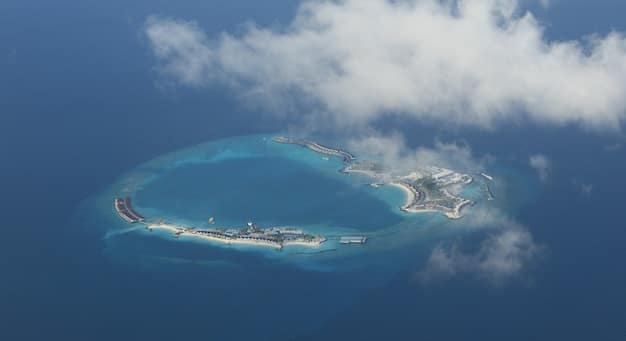US Military in South China Sea: Diplomatic Repercussions

The diplomatic implications of the US’s increased military presence in the South China Sea include heightened tensions, strained relations with China, potential for miscalculation, and increased multilateral engagement to balance regional power dynamics.
The South China Sea has become a hotbed of geopolitical contestation. The increased US military presence in the region, ostensibly aimed at ensuring freedom of navigation and maintaining regional stability, carries significant diplomatic implications that demand careful examination.
Understanding US Military Presence in the South China Sea
The United States has steadily increased its military activities in the South China Sea, citing the need to uphold international law and freedom of navigation. This posture is a direct response to China’s assertive territorial claims and construction of artificial islands in the region.
Rationale Behind US Military Actions
The US contends that its military presence is crucial for maintaining a balance of power, ensuring the free flow of commerce, and deterring any unilateral attempts to alter the status quo.
Nature of US Military Operations
These operations include freedom of navigation operations (FONOPs), joint military exercises with allies, and increased surveillance activities. FONOPs involve US warships sailing within 12 nautical miles of the disputed islands claimed by China, asserting the US interpretation of international law.

These activities, however, are viewed by China as provocative and an encroachment on its sovereignty. The nature of these operations has led to a complex web of diplomatic challenges.
Strained Bilateral Relations Between the US and China
One of the most evident diplomatic implications is the exacerbation of tensions between the US and China. The increased military presence has led to a more confrontational dynamic, with both nations engaging in strong rhetoric and reciprocal actions.
Impact on Diplomatic Engagements
The South China Sea issue has consistently been a point of contention in bilateral meetings between the two countries. It overshadows other areas of potential cooperation, such as trade, climate change, and global health.
Risk of Miscalculation
The heightened military activity increases the risk of miscalculation or accidental encounters that could escalate into a larger conflict. This dynamic is exacerbated by a lack of transparency and trust between the military establishments of both nations.
To mitigate these risks, diplomatic efforts aimed at establishing clear communication channels and protocols for de-escalation are essential. Both countries must prioritize dialogue and mutual understanding to avoid unintended consequences.
Regional Reactions and Alliances
Other nations in the region, particularly those with competing claims in the South China Sea, have varying reactions to the US military presence. Some welcome it as a counterweight to China’s growing influence, while others are wary of being caught in the middle of a great power rivalry.
Support from Allies
Countries like the Philippines, Vietnam, and Australia have generally supported the US presence, seeing it as crucial for maintaining regional stability. These nations have engaged in joint military exercises with the US, signaling a united front against China’s assertiveness.
Concerns of Smaller Nations
Smaller Southeast Asian nations, however, are more cautious. They rely heavily on trade with China and are hesitant to take sides in the US-China rivalry. These nations often prefer a multilateral approach, emphasizing diplomacy and adherence to international law.
- Economic Considerations: Many Southeast Asian nations rely heavily on trade with China, making them hesitant to openly oppose Chinese actions.
- Neutrality and Non-Alignment: Some nations prefer to maintain a neutral stance to avoid being drawn into a great power rivalry.
- Multilateral Diplomacy: ASEAN provides a platform for addressing the disputes collectively through dialogue and negotiation.
Maintaining open channels of communication and respecting the sovereignty of all nations in the region is critical for fostering a stable and cooperative environment.
International Law and Freedom of Navigation
The US defends its military presence in the South China Sea as being in accordance with international law, particularly the principle of freedom of navigation. This principle, enshrined in the United Nations Convention on the Law of the Sea (UNCLOS), ensures that ships and aircraft can transit through international waters without undue interference.
China’s Interpretation of UNCLOS
China, however, interprets UNCLOS differently, arguing that its historical claims and sovereign rights in the region supersede the convention. This divergence in interpretation forms the basis of the legal and diplomatic dispute.
FONOPs as a Tool of Diplomacy
US FONOPs are not only military exercises but also diplomatic signals. They assert the US’s rejection of China’s expansive claims and reaffirm its commitment to upholding international law. These operations challenge China’s attempts to restrict access to the South China Sea.

The diplomatic implications of these legal disagreements extend to international forums, such as the International Court of Justice and various UN bodies, where the legitimacy of territorial claims and maritime rights are debated.
Multilateral Engagement and ASEAN
The Association of Southeast Asian Nations (ASEAN) plays a crucial role in managing the diplomatic tensions surrounding the South China Sea. ASEAN provides a platform for dialogue and negotiation, bringing together claimant states and external powers like the US and China.
ASEAN’s Approach to the Dispute
ASEAN’s approach is based on consensus-building and non-interference. It seeks to promote a code of conduct that would govern the behavior of parties in the South China Sea and prevent escalation.
Challenges to ASEAN’s Effectiveness
However, ASEAN’s effectiveness is limited by its internal divisions and the varying levels of influence that China and the US exert on its member states. Some ASEAN members are more aligned with China, while others lean towards the US.
To enhance ASEAN’s role, external powers must support its efforts to promote dialogue and cooperation. This includes refraining from actions that could undermine ASEAN unity and respecting its central role in regional diplomacy.
Potential for De-escalation and Conflict Resolution
Despite the current tensions, there are avenues for de-escalation and conflict resolution in the South China Sea. These include diplomatic negotiations, confidence-building measures, and joint development projects.
Diplomatic Negotiations
Direct talks between the US and China, as well as among the claimant states, are essential for addressing the root causes of the dispute. These negotiations should focus on clarifying territorial claims, establishing rules of engagement, and promoting transparency.
Confidence-Building Measures
CBMs, such as hotlines between military commanders and joint patrols in non-disputed areas, can help reduce the risk of miscalculation and build trust. These measures should be expanded to include more inclusive participation.
Joint Development Projects
JDPs, such as joint exploration of oil and gas resources, can create incentives for cooperation and shared prosperity. These projects should be structured in a way that benefits all parties and respects their sovereign rights.
Ultimately, a peaceful resolution to the South China Sea dispute requires a commitment to diplomacy, mutual respect, and adherence to international law. All parties must prioritize dialogue and cooperation over confrontation and unilateral actions.
Looking Ahead: Future Diplomatic Strategies
The diplomatic strategies employed by the US, China, and other stakeholders will shape the future of the South China Sea. A combination of assertive diplomacy, multilateral engagement, and confidence-building measures will be necessary to manage the tensions and prevent escalation.
US Strategy
The US should continue to uphold freedom of navigation and international law while also seeking to establish a more constructive dialogue with China. This includes clear communication of its intentions and a willingness to address China’s legitimate security concerns.
China’s Strategy
China should demonstrate restraint in its actions and engage in meaningful negotiations with other claimant states. This includes clarifying its territorial claims and adhering to the principles of UNCLOS.
Regional Cooperation
Regional cooperation through ASEAN should be strengthened, with external powers providing support for its efforts to promote dialogue and conflict resolution.
By pursuing these strategies, the stakeholders can work towards a more stable and cooperative future in the South China Sea, ensuring that it remains a region of peace and prosperity.
| Key Point | Brief Description |
|---|---|
| ⚠️ US Military Presence | Increased activities to uphold freedom of navigation and counter China. |
| 🤝 Regional Alliances | Varying reactions; some support, others wary of great power rivalry. |
| ⚖️ International Law | US asserts freedom of navigation, China cites historical claims under UNCLOS. |
| 🕊️ Conflict Resolution | Diplomacy, confidence-building, and joint development are key. |
Frequently Asked Questions
▼
The US says it is to maintain freedom of navigation, uphold international law, and counter China’s territorial claims and militarization of disputed islands.
▼
China views the US military presence as provocative, an encroachment on its sovereignty, and an interference in regional affairs, complicating bilateral relations.
▼
ASEAN provides a platform for dialogue, promoting a code of conduct to manage tensions. Its effectiveness is limited by internal divisions and external influences.
▼
Solutions include diplomatic negotiations, confidence-building measures, and joint development projects to foster cooperation and shared prosperity.
▼
The future depends on diplomatic strategies employed by involved nations, combining diplomacy, multilateral engagement, and confidence-building for regional stability.
Conclusion
The diplomatic implications of the US’s increased military presence in the South China Sea are multifaceted, encompassing strained bilateral relations, regional reactions, international law, and multilateral engagement. Navigating these complexities requires a commitment to diplomacy, mutual respect, and adherence to international law to ensure regional peace and prosperity.





